  At top left, U.S. Energy Secretary Jennifer Granholm presents the Secretary of Energy Excellence Award to Cynthia T. Strowbridge; at top right, Granholm hands the Secretary of Energy Excellence Award to Bruce Martin. Both Strowbridge and Martin work in the Office of the Assistant Secretary for Environmental Management at the Savannah River Site. Pictured in the photo immediately above, from left, are EM Senior Advisor William “Ike” White, Strowbridge, Martin, EM Principal Deputy Assistant Secretary Jeff Avery and DOE-Savannah River Operations Office Manager Mike Budney.
Additional EM employee was honored for past role in DOE Office of Legacy Management team
WASHINGTON, D.C. — EM racked up eight of the Secretary’s Honor Awards for 2023, with DOE recognizing two employees at the Savannah River Site (SRS) for excellence and six teams from the Idaho, Hanford, Portsmouth and Oak Ridge sites for achievements.
The EM wins are among 67 Honor Awards for last year. The Department bestowed 53 teams with the Secretary of Energy Achievement Award and 14 individuals with the Secretary of Energy Excellence Award.
The Honor Awards are the highest form of internal recognition an employee or contractor can receive from the Department. The awards recognize those who display a high level of performance and leadership in their dedication to public service.
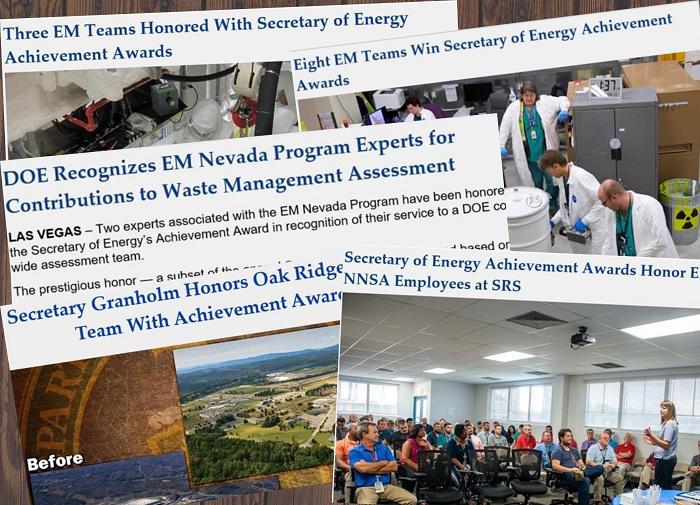 EM WINNING STREAK: News that EM recently won eight of the Secretary’s Honor Awards for 2023 follows years of significant recognition for the cleanup program in the annual awards program.
U.S. Energy Secretary Jennifer Granholm presented Cynthia T. Strowbridge and Bruce Martin from the Office of the Assistant Secretary for Environmental Management at SRS with Excellence Awards in a ceremony last week. A virtual ceremony for Achievement Award recipients is set for 10 a.m. Eastern Time on Feb. 20.
Cynthia T. Strowbridge
Honored for setting the standards for contracting officers on large cleanup projects, Strowbridge was instrumental in negotiating and administering the Integrated Mission Completion Contract at SRS. She also helped facilitate the award of task orders worth over $1.8 billion integral to reducing environmental liability in South Carolina and ensuring taxpayers get the maximum value for the dollars spent on cleaning up liquid waste at SRS.
Bruce Martin
Martin’s innovative pension strategy at SRS has protected workers’ financial futures while saving taxpayers over $400 million. His creative thinking, diligence and analysis played a hand in extensive coordination across DOE and negotiations with interagency partners.
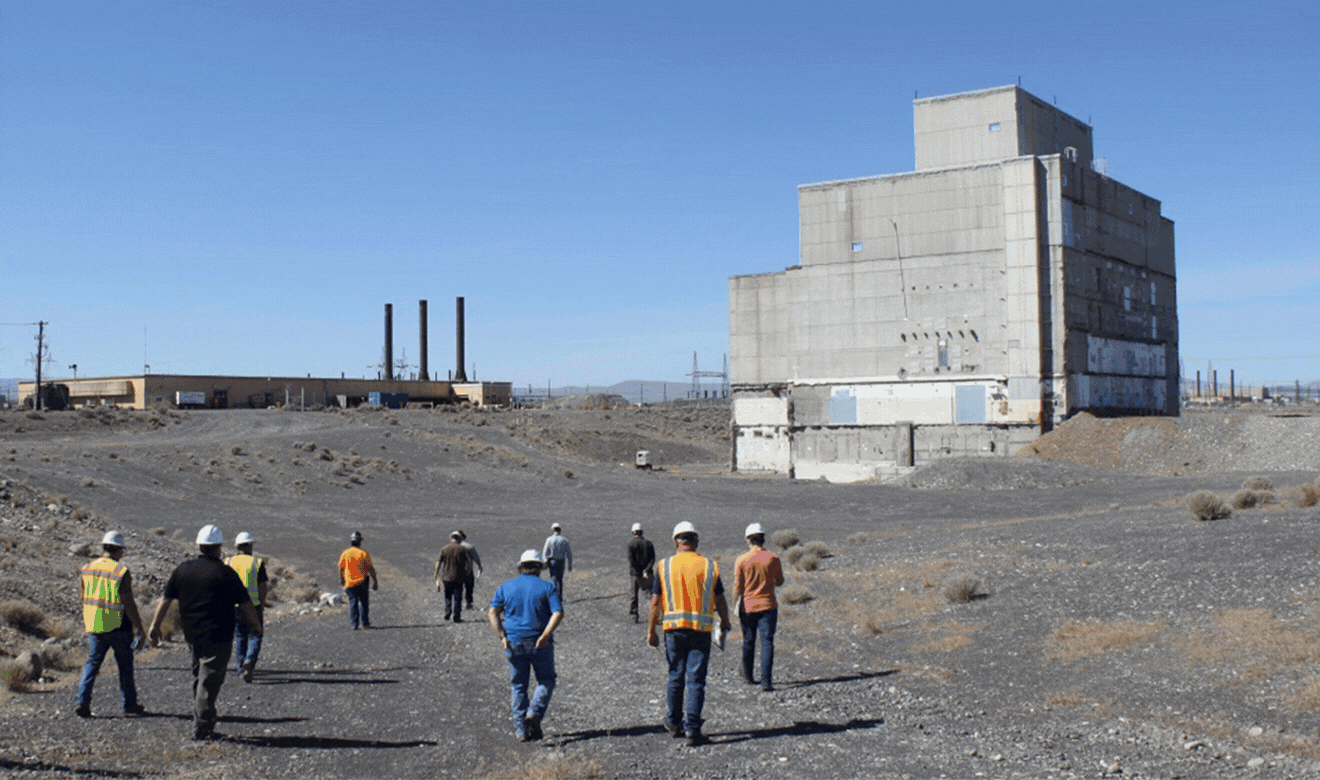 Workers with EM contractor Central Plateau Cleanup Company finished building a protective enclosure, or cocoon, over the former K East Reactor building at the Hanford Site in 2022. The cocoon is designed to protect the reactor building while the radioactivity in the deactivated reactor core decays over the next several decades, making it safer to complete disposition of the reactor in the future. In the third photo above, Hanford Site officials are pictured at a media event marking the project completion. From left are Travis Creach, K East Interim Safe Storage construction manager, Central Plateau Cleanup Company (CPCCo); Paul Branson, K East Interim Safe Storage project manager, CPCCo; Brian Vance, manager, EM Office of River Protection (ORP) and Richland Operations Office (RL); Brian Stickney, deputy manager, ORP and RL; John Eschenberg, president, CPCCo; and Rob Roxburgh, communications director, CPCCo.
DOE honored six EM teams with Achievement Awards for their outstanding work in the cleanup program:
105K East Reactor Interim Safe Storage Project Team at Hanford Site
This team received recognition for placing the K East Reactor in interim safe storage ahead of schedule and under budget. The safe and cost effective completion of this project marks a significant and visible accomplishment in the Department’s mission to reduce risk to the nearby Columbia River in Washington state. The project was among EM’s key construction priorities for 2022.
Hanford Site Holistic Negotiations Team
This Achievement Award is for the team’s success in reaching a conceptual agreement with the Washington State Department of Ecology and U.S. Environmental Protection Agency on a path to treat, immobilize and dispose of Hanford’s tank waste. The result of three years of discussions and more than 70 mediated sessions, the conceptual agreement upholds the Tri-Party Agreement agencies’ shared commitment to a safe, affordable and achievable path that aligns with the agencies’ shared priorities and commitment to advance the Hanford cleanup mission.
Integrated Waste Treatment Unit Initiation of Waste Processing Project Team at Idaho National Laboratory Site
This Idaho Cleanup Project federal-and-contractor team was honored for its extraordinary dedication to safely initiate radioactive liquid tank waste processing in April last year. Their efforts substantially contributed to completing commitments to the State of Idaho and protecting the Snake River Plain Aquifer, and their professionalism and dedication to protecting workers, the public and the environment leaves a legacy of clean water for Idaho residents.
Oak Ridge Regulatory and Community Engagement Team
After several years of intense effort, this team achieved regulatory approval of and community support for construction of the Environmental Management Disposal Facility, a new onsite hazardous waste disposal facility. This accomplishment allows environmental cleanup to continue uninterrupted across the Oak Ridge Reservation while saving taxpayers nearly $1 billion. Team members used their expert knowledge of environmental statutes and deep understanding of the desires of the local community to persuade local, state and federal regulators and the public to support construction of the facility.
Portsmouth Site X-326 Demolition Project Team
This Portsmouth/Paducah Project Office team was recognized for its extraordinary work to safely demolish the iconic Portsmouth X-326 Uranium Enrichment Process Building. Completed with zero accidents, ahead of schedule and under cost, the successful demolition of this building was a critical first step in advancing the cleanup of the Portsmouth Site and became a central unifying goal for the entire site. Not only did these efforts result in a profound change to the Portsmouth skyline, they demonstrated the Department’s commitment to safe and compliant cleanup of the Portsmouth Site to Southern Ohio communities.
 Employees supporting the spent nuclear fuel wet-to-dry project at the Idaho National Laboratory Site celebrate the last fuel elements removed from a water-filled basin within a building at the Idaho Nuclear Technology and Engineering Center. The Experimental Breeder Reactor-II fuel was safely transported to the site’s Materials and Fuels Complex. Crews completed the 1995 Idaho Settlement Agreement milestone in March 2023, more than nine months ahead of schedule.
Spent Nuclear Fuel Wet-to-Dry Project Team at the Idaho National Laboratory Site
DOE honored this Idaho Cleanup Project (ICP) federal-and-contractor team for safely transferring thousands of spent nuclear fuel elements from wet to dry storage and completing the project more than nine months ahead of a 1995 Idaho Settlement Agreement milestone. A significant accomplishment more than two decades in the making, the project required close coordination among many parties, including ICP federal management and staff, the DOE Office of Nuclear Energy, Office of Naval Reactors Idaho Branch Office, and EM cleanup contractor Idaho Environmental Coalition. Team members were also steadfast in their commitment to ensure adequate protection of the Snake River Plain Aquifer.
 |
|
EM Office of External Affairs Public Affairs Specialist Karen Edson was honored as part of the DOE Office of Legacy Management (LM) Beneficial Reuse Program Team, which was recognized with a Secretary of Energy Achievement Award. Edson had served in a past role as a public participation specialist in LM.
|
In addition, a number of EM employees will receive DOE Cross-cutting Team Achievement Awards. These teams together accomplished significant achievements on behalf of the Department.
Karen Edson, a public affairs specialist with EM’s Office of External Affairs, was part of the DOE Office of Legacy Management (LM) Beneficial Reuse Program Team, which was honored with a Secretary of Energy Achievement Award.
This team plays a vital role in the success of LM's mission of long term surveillance and maintenance of defense nuclear sites that helped bring about the end of the Cold War. One of LM's top priorities is getting properties back into reuse in a safe, efficient and productive manner while ensuring that the history and heritage of the important sacrifices and many innovations made during that era remain alive for many generations to come.
-Contributors: Carly Howard, Matt Roberts, David Sheeley
  Isotek employees load a canister containing uranium-233 material into a hot cell for processing at Oak Ridge. They will extract thorium-229 from the material before downblending the material for shipment and disposal.
OAK RIDGE, Tenn. — One of the Oak Ridge Office of Environmental Management’s (OREM) highest priority cleanup projects has significantly contributed to the medical world.
OREM and contractor Isotek are leading an effort to eliminate the nation’s inventory of uranium-233 (U-233) from storage at Oak Ridge National Laboratory (ORNL).
U-233 presents risks and is costly to keep safe and secure. Originally created in the 1950s and 1960s for potential use in reactors, it proved to be an unviable fuel source.
OREM’s project is converting that material into a form safe for shipment and disposal. Additionally, an agreement with TerraPower is allowing Isotek employees to extract thorium-229 (Th-229), an extremely rare isotope, from the material before it is processed and disposed of.
“It’s important to extract Th-229 because that isotope only comes from U-233,” said Sarah Schaefer, Isotek president and project manager. “Most of the world’s supply of U-233 is stored at ORNL, so once this material is dispositioned no more Th-229 will be available.”
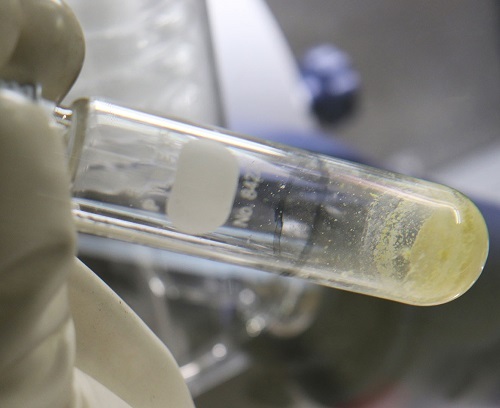 |
|
Most of the world’s thorium-229 is contained in Oak Ridge’s inventory of uranium-233. A project at the site estimates 40 grams of the material will be available to TerraPower, which will make 100 times more doses of next generation cancer treatments available annually than are currently available worldwide. |
Isotek extracts the Th-229 before it’s shipped to TerraPower. The company has already received more than five grams of the rare material through seven shipments from the Oak Ridge project. Then, it uses that material to recover actinium-225 (Ac-225), a medical isotope behind a promising form of next generation cancer treatment called targeted alpha therapy.
TerraPower just announced it distributed the first samples of Ac-225 to two pharmaceutical companies to support the development of the revolutionary cancer treatment.
“Isotek’s mission is critical to saving this rare isotope,” said Schaefer. “We are so fortunate that a company like TerraPower was willing to invest in the recovery of Th-229.”
 U.S. Rep. Chuck Fleischmann speaks at an event last year announcing TerraPower’s plans to partner with medical companies to distribute medical isotopes for cancer treatments. Also pictured are leaders from EM, Isotek, TerraPower and Cardinal Health.
Once all Th-229 has been extracted over the next four years — an estimated 40 grams — 100 times more doses of next generation cancer treatments will be available annually than are currently available worldwide.
“Thanks to this partnership, the lives of many families will be changed for the better,” AtkinsRéalis US Nuclear President Jim Rugg said. “We are honored to be assisting the U.S. Department of Energy and TerraPower with this historic achievement.”
Isotek is a wholly owned subsidiary of AtkinsRéalis US Nuclear.
In treatments, the Ac-225 is attached to a molecule to selectively target and deliver the alpha-emitting radionuclide to a cancer site, destroying the cancerous tissue with minimal damage to nearby healthy cells.
Global demand for Ac-225 is expected to increase as more treatments are developed, making the work performed by OREM and Isotek more vital and impactful.
-Contributor: John Gray
  A new H Canyon laboratory uses an existing and unused fume hood in H Canyon at Savannah River Site. This small setup will lead to time and cost savings when sampling solution from a general purpose evaporator.
AIKEN, S.C. — DOE’s prime contractor at the Savannah River Site (SRS) recently worked with EM’s national laboratory to create a new sample analysis laboratory that will decrease processing downtime and save taxpayer dollars.
Until the recent addition of the H Area laboratory, samples from tanks associated with a piece of equipment known as a general purpose evaporator were sent across the site to Savannah River National Laboratory (SRNL) for analysis.
“The process of pulling samples, packaging them, sending them approximately 10 miles across SRS and then giving SRNL time to sample could take as little as one to two days, and at times, take as long as six days, depending on what day of the week the sample was pulled and the workload of the laboratory,” said Regina Marquez, H Area Laboratory Project lead engineer with Savannah River Nuclear Solutions (SRNS), the site’s managing and operating contractor. “It was determined that this downtime could be eliminated with the creation of a laboratory in H Area that could do the sample analysis as needed.”
The evaporator concentrates low-level radioactive solutions from various sources, including sump material, laboratory waste and rainwater, ensuring H Canyon produces as little waste as possible.
“To ensure the facility is in compliance with the technical safety requirements, we sample the solution in the tanks that feed the general purpose evaporator prior to processing,” Marquez said. “If the sample results come back acidic, we add caustic, a strong base that is soluble in water, to bring the pH up to basic levels.”
Establishing a new laboratory involved procuring a new piece of analytical equipment and ensuring all safety and laboratory standards were met.
“SRNL was very supportive of our efforts to implement the lab by ensuring we met all technical requirements so that our sample analysis would be in compliance with laboratory standards,” Marquez said. “Even the simplest lab analysis is complicated when it involves maintaining the high standards of safety associated with our type of work.”
SRNL also helped write the procedure needed to run the analytical equipment and to train H Canyon operators on its use.
“This was a major factor in getting the lab up and running, as H Canyon operators had never performed this type of work before,” Marquez said. “This project required all hands on deck and SRNL stepped up.”
Since the new laboratory has begun operating, downtime due to sample analysis has reduced from two to six days to four hours at most.
“This will lead to significantly reduced costs as well,” she said.
DOE-Savannah River Senior Program Manager Jeff Bentley said DOE appreciates the effort and collaboration between SRNL and SRNS to implement the laboratory that saves time and costs.
“SRS prides itself on continuously improving and looking for better and more cost effective ways to safely perform some of the Department’s most important nuclear related missions,” Bentley said.
-Contributor: Lindsey MonBarren
 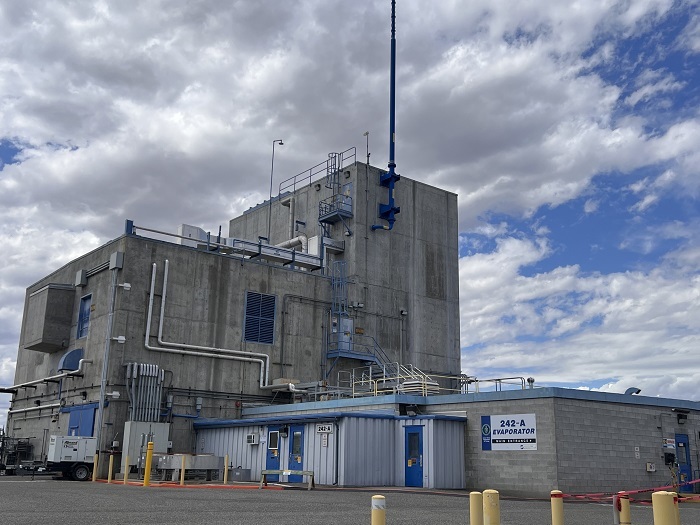 The 242-A Evaporator is fundamental to the Hanford Site’s Direct-Feed Low-Activity Waste Program.
RICHLAND, Wash. – A facility with a critical role in the Hanford Site tank waste cleanup mission is gearing up to restart operations after a series of upgrades and repairs.
The 242-A Evaporator removes water from radioactive and chemical waste stored in underground tanks to create more storage space in them. Since the facility last operated in 2019, EM Office of River Protection tank operations contractor Washington River Protection Solutions installed 1,300 feet of new waste-transfer lines between the evaporator and a nearby underground tank-waste storage area, known as a tank farm.
Improvements also include a safety system upgrade to enhance the efficiency of equipment testing required prior to an evaporator campaign.
“These improvements will ensure Hanford’s evaporator is efficient and dependable for its long term mission,” said Delmar Noyes, Office of River Protection assistant manager for Tank Waste Operations. “Creating more storage space in double-shell tanks allows us to continue to retrieve waste from older single-shell tanks and prepare them for the next phase in cleanup: treating tank waste via vitrification, or immobilization in glass.”
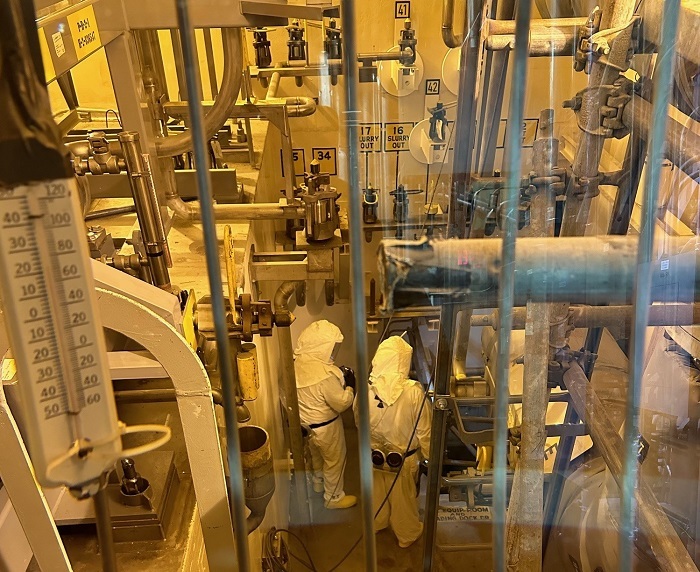 Crews conduct an initial inspection inside the Hanford Site’s 242-A Evaporator to prepare for system startup.
The tank farm feeds waste to the evaporator, which boils it at low pressure to evaporate water from it. The resulting waste slurry is then transferred back to a nearby double-shell tank for safe storage. Meanwhile, the evaporated water is filtered and sent to Hanford’s Effluent Treatment Facility for additional treatment and disposal.
“Our dedicated and talented team has been working hard to tackle the challenges of this restart effort, setting up the 242-A Evaporator to operate safely and efficiently as Hanford increases its pace of operations,” said Monica Kembel, the contractor’s Production Operations manager.
Hanford’s evaporator has removed more than 81 million gallons of liquid from the site’s waste tanks over the past four decades. The evaporator is scheduled to restart in summer 2024.
-Contributor: Kristin M. Kraemer
 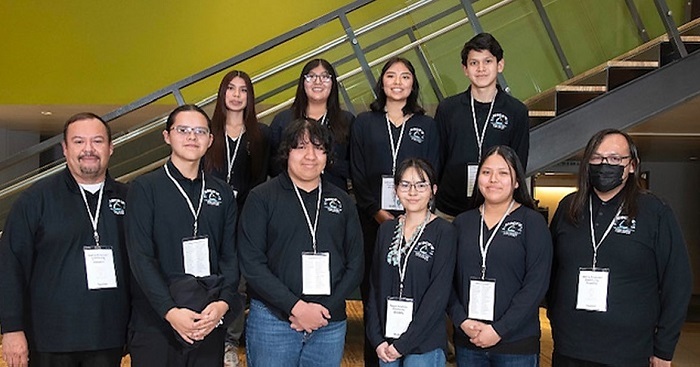 The Native American Community Academy Pure Water Action Team was one of 40 high school teams from across New Mexico to participate in the 2024 Governor’s STEM Challenge sponsored by companies such as Newport News Nuclear BWXT Los Alamos, EM’s legacy cleanup contractor at Los Alamos National Laboratory.
SANTA FE, N.M. — Representatives with the EM Los Alamos Field Office legacy waste cleanup contractor at Los Alamos National Laboratory joined students from the Native American Community Academy (NACA) of Albuquerque to promote STEAM Day at the New Mexico Legislature recently.
Newport News Nuclear BWXT Los Alamos (N3B) sponsored the NACA Pure Water Action Team’s participation in the 2024 New Mexico Governor’s STEM Challenge. The team’s subject in the annual, statewide competition focused on reducing arsenic from water using magnetic hydroxyapatite beads. Participants vie for monetary prizes and the opportunity to meet with potential employers in their field. Winning teams receive $500 per student.
The NACA team joined other organizations for the STEAM Day event at the state capitol building in Santa Fe. The students, along with a group of N3B employees led by Engineering and Nuclear Safety Program Manager Nichole Lundgard, were able to meet with legislators and others to reinforce the need for STEAM — science, technology, engineering, arts and math — education in schools.
“As an environmental cleanup company, we were pleased to participate with NACA in the Governor’s STEM Challenge and the visit to the state capitol to present their project on reducing arsenic in water,” Lundgard said.
 Nichole Lundgard and Jeffery Lucero with Newport News Nuclear BWXT Los Alamos (N3B) were members of the N3B team accompanying the Native American Community Academy Pure Water Action Team to STEAM Day at the New Mexico Legislature in Santa Fe on Feb. 1.
Lundgard was impressed with the group and their dedication to their project.
“They have gone so far as to link with Sandia National Laboratories in Albuquerque to put their prototype into production,” she said.
In addition, N3B’s Jeffery Lucero, an engineer and member of the Zia and Cochiti pueblos, was able to share his experiences with the students.
N3B has sponsored the Governor’s STEM Challenge since its inception in 2019.
-Contributors: Brian Leugs, Todd Nelson

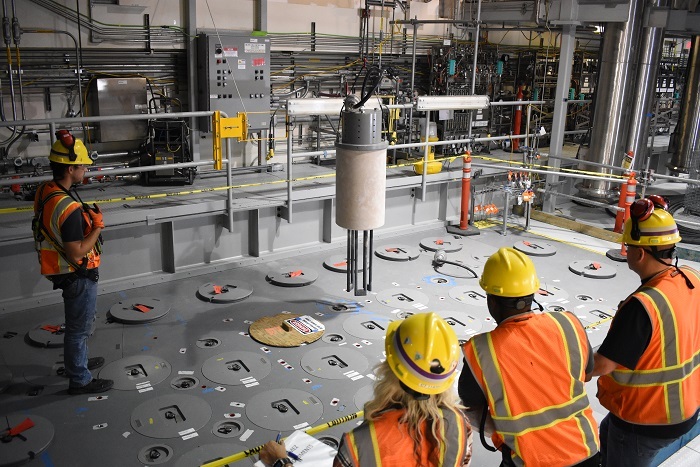 RICHLAND, Wash. — EM crews at the Hanford Site's Waste Treatment and Immobilization Plant recently installed 18 temporary startup heaters, one of which is pictured, in the second of two melters in the plant’s Low-Activity Waste Facility. The heaters are installed through ports in the lid of the melter and will raise the melter’s operating temperature to 2,100 degrees Fahrenheit — hot enough to sustain a pool of molten glass. Once the operating temperature is achieved and a molten glass pool is established, crews will remove the startup heaters and replace them with bubblers, pieces of equipment that introduce air into the molten glass to circulate it and maintain an even temperature. Hanford contractor Bechtel National Inc. is designing, constructing and commissioning the plant for EM’s Office of River Protection. When complete, the plant will process and stabilize millions of gallons of legacy tank waste using a process known as vitrification, during which the waste will be mixed with glass-forming materials, incorporated into molten glass, and poured into stainless steel containers for safe disposal.
 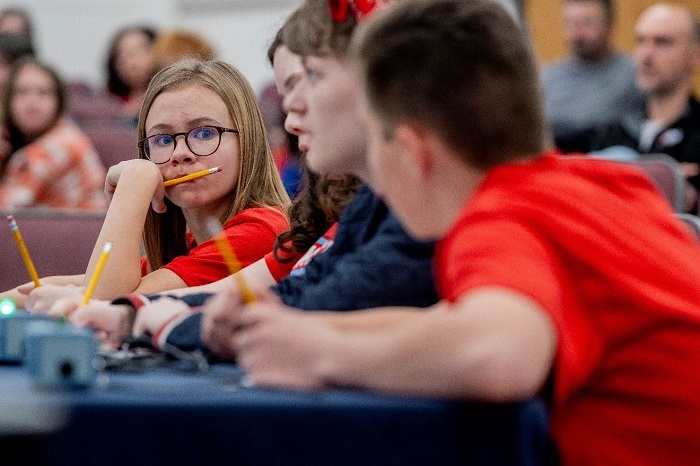 Hayden Loveless, left, listens to Calloway County Middle School Science Bowl Team #1 members during a bonus question at the DOE West Kentucky Regional Science Bowl.
PADUCAH, Ky. — Calloway County Middle School Team #1 on Friday won DOE’s West Kentucky Regional Science Bowl, an event recognized as the region’s most notable science competition for middle school students.
The five-member team will now compete in DOE’s National Science Bowl finals in Washington, D.C., from April 25-29.
“We are so thankful for the opportunities that DOE provides for our students in western Kentucky. It is always an honor to compete in the DOE West Kentucky Regional Science Bowl. They give our students the support to dream big,” Calloway County Middle School Team #1 Coach Scott Pile said.
In other recent Kentucky Science Bowl news, Calloway County High School Team #1 won this year’s West Kentucky Regional Science Bowl on Feb. 2, culminating months of planning by volunteers and coaches for an event touted as the region’s most prominent science competition for high school students.
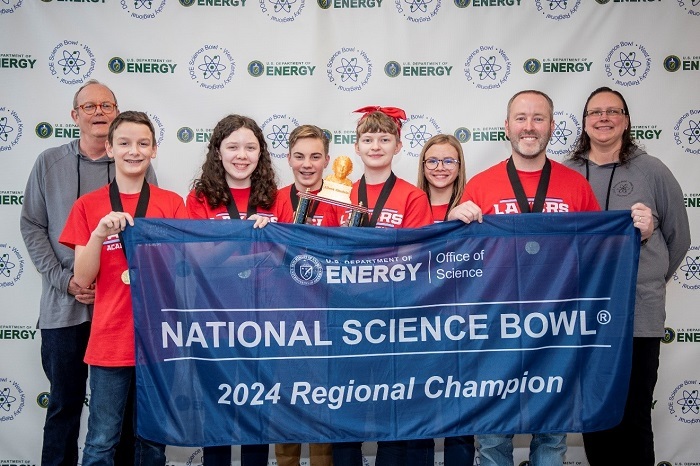 EM Portsmouth/Paducah Project Office Program Analyst Robert “Buz” Smith, far left, and EM Paducah Site Lead April Ladd, back row, far right, pose with DOE West Kentucky Regional Science Bowl champion Calloway County Middle School Team #1 team members, from left, Colin Naber, Ava Bogard, Theodore Perlow, Ella Martin, Hayden Loveless and coach Scott Pile.
Fifteen middle school teams competed during this year’s regional competition, an event celebrating its 16th year. Volunteers conducted extensive training to prepare coaches, volunteers and competitors in advance of the event.
Heath Middle School Team #1 finished second and the North Marshall Middle School Team finished third in the regional competition.
Other schools competing in this year’s event included Ballard County, Henderson County North, Hopkinsville, Lone Oak, Murray, Paducah and Reidland middle schools in Kentucky and Massac County Junior High School in Illinois.
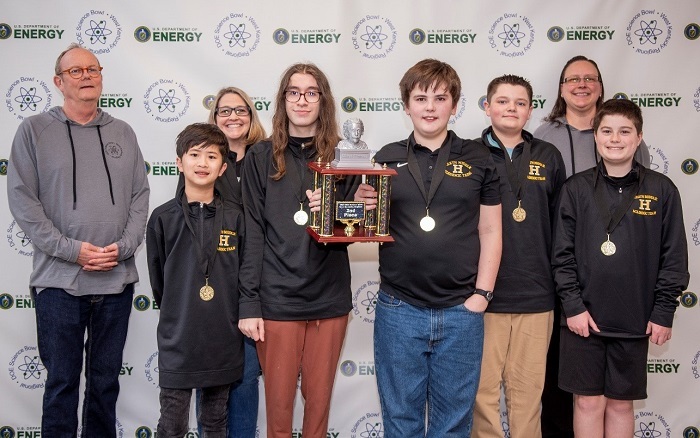 From left, EM Portsmouth/Paducah Project Office Program Analyst Robert “Buz” Smith; Heath Middle School Team #1 Team members Janus Cheung, coach Brandy Roberts, Max Steger, Drew Byrne, McCoy Mitchell, Finn Boyd; and EM Paducah Site Lead April Ladd, back row, pose for a photo with the runner-up trophy at the DOE West Kentucky Regional Science Bowl.
A quick-recall, fast-paced, question-and-answer contest, the tournament is designed to quiz students on their knowledge of biology, chemistry, Earth and space, energy, mathematics and physics.
“The amount of time the students, coaches and volunteers put into preparing for this event is always amazing,” EM Paducah Site Lead April Ladd said. “The knowledge displayed by students on all the teams continues to impress.”
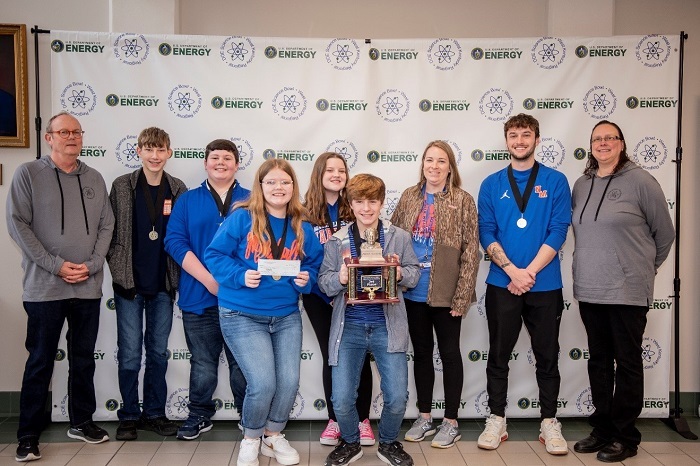 EM Portsmouth/Paducah Project Office Program Analyst Robert “Buz” Smith, far left, and EM Paducah Site Lead April Ladd, far right, pose with DOE West Kentucky Regional Science Bowl second-runner-up, North Marshall Middle School Team. Pictured are, back row, from left, Quintin Milo, John “JD” Wyatt, Edie Jones, coach Megan Rickard, coach Aaron Smith, and front row, from left front, Elizabeth Munson and Nathan Downs.
The first place team in the regional tournament will receive $1,200 for its school. Each year, about 10,000 students from across the country compete in the national competition. More than 344,000 students have competed since the event began 33 years ago.
The event is organized by EM Portsmouth/Paducah Project Office employees and contractors. More than 110 volunteers serve as moderators, judges, technical advisors and scorekeepers. DOE’s Office of Science manages the National Science Bowl finals competition. Click here for more information.
-Contributor: Dylan Nichols
|